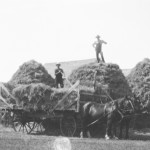Little known today, either in Manitoba or outside the province, the Winnipeg Light Agricultural Motor Contests were on the cutting edge of the new technology of the tractor. In fact, the tractor was so new in 1908 that the word tractor had not even been invented. The Winnipeg contests were the first effort to scientifically

When Manitoba set the standard for tractors
A forgotten Manitoba competition tested early tractors for prospective buyers

The George Kent outfit
A chance find in an old magazine shows a Manitoba threshing crew in action
While researching the Winnipeg Tractor Trials we reviewed copies of the Canadian Threshermen and Farmer and in a 1904 edition, came across this image of the George Kent outfit, which consisted of a Waterous 22 horsepower steam engine and a 35×50 McCloskey separator. George Kent farmed somewhere around Shoal Lake. The photo contains a wealth

Threshing from the stack
Each photograph from pioneer days is a window into a world gone by
Sometimes it’s amazing the amount of details you can spot in old photographs. In the fall of 2014, Bruce Black of the Brandon area let the Manitoba Agricultural Museum copy negatives of historic photographs taken on his family’s farm in the Brandon area. The museum was able to digitize the images taken from the negatives.

Old-time grain storage systems
Stacking sheaves was an important task but one that was rarely photographed
In the fall of 2014, Bruce Black of the Brandon area lent the museum copy negatives of photographs taken on the farms operated by the Black family in the Brandon area. The museum was able to digitize the images taken from the negatives. Photos in this period are not common, as cameras and film were
OUR HISTORY: 1800s — 1940s
Getting around in the early days The Manitoba Agricultural Museum is opening a new transportation display on Manitoba Day May 12. The display tells the story of transportation in rural Manitoba from the Red River cart of the 1800s right through to the vehicles of the 1940s. It uses real artifacts from the various eras
Our history: A bird’s-eye view of Austin
The storage archives of the Manitoba Agricultural Museum hold a number of items that the museum cannot display due to lack of proper display facilities. One of the pieces is the promotional booklet Austin, Manitoba The Sort of Home You’ve been Looking for printed by the Austin Board of Trade circa 1912. A photo in
Ideal tractor testament to the golden age of manufacturing
These days, social media, software and other digitally focused companies occupy the apex of innovation. But a century ago, many of the brightest and most creative young minds were drawn to manufacturing. Consider the Goold, Shapley and Muir “Ideal” tractor shown in the accompanying photograph. Headquartered in Brantford, Ont., but with branches in Winnipeg, Regina

